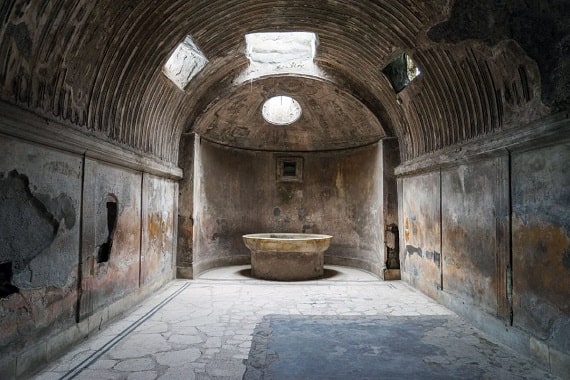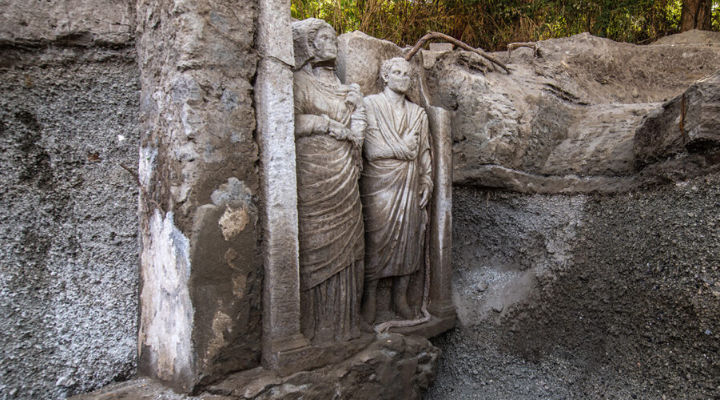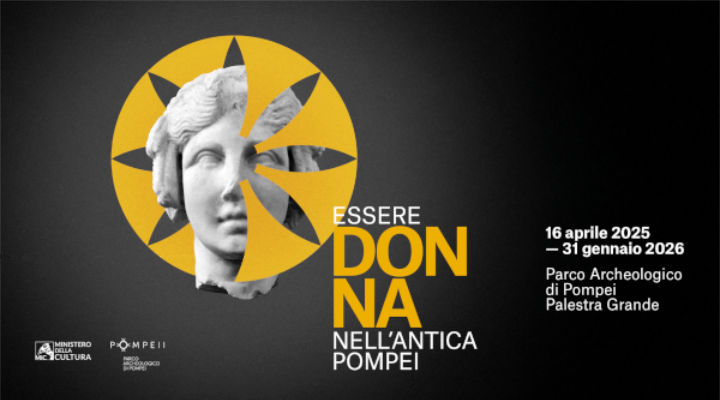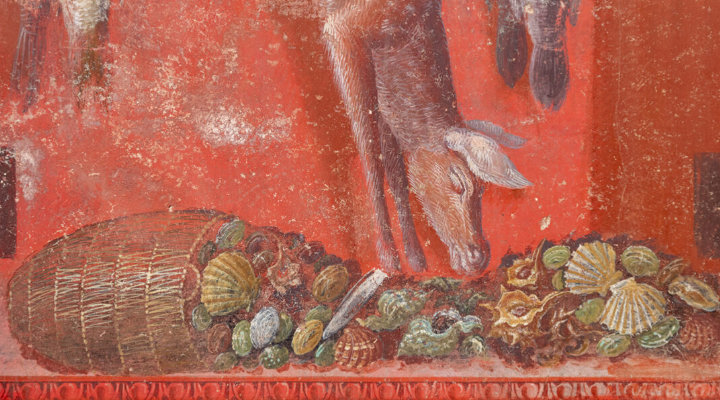
The "thermae" were the city's public baths. There were relatively few private baths and these were limited to the most well-to-do families, given that the latter were the only ones who could afford to build rooms suited to the purpose.
The thermal bath buildings were divided into two sections: one reserved for women and one reserved for men. Each of these contained a series of rooms with different functions:
1) apodyterium or changing room
2) frigidarium or cold bath room
3) tepidarium or tepid bath room
4) calidarium or hot bath room.
The thermal baths included latrines and, in the most developed type, a pool and gymnasium. They were often furnished with open spaces and gardens.
The system of heating the rooms - which was fairly ingenious -worked by running heated water through the cavities in the wall.
The Thermae were not only buildings used for a function of public utility, but also played a very important social role in that they provided an important place for people to meet.
STABIAN THERMAL BATHS
These occupy a vast area between the Brothel lane, the Holconius crossroads and the Via Stabiana. They represent the oldest thermal complex in the city. In fact they were built at the time of Pompeii's subjugation to Rome and were subsequently extended and decorated on more than one occasion to answer more adequately the needs of the growing population. The original construction, situated in the northern part of the building beyond the colonnades, is from the Samnite period. The more recent part - dating back to the renovation of the Roman age - overlooks the western side: it is organized according to more modern and functional criteria.
The thermal complex consists of a well-constructed system of baths distributed around a cen
tral area used as a gymnasium and characterized by a colonnade ranged round three sides of the building.
The Stabian Baths are composed of three parts: the rooms in the north section, those mentioned above as being the oldest, contain a series of latrines. The second section consists of a group of private baths situated behind the northern colonnade. The third section is located in the eastern part: it is made up of changing rooms, a vestibule - with magnificent plaster decoration - rooms for the cold bath (frigidarium), for the tepid bath (tepidarium) and for the hot bath ((alidarium).
The Thermal Baths are rigidly divided between the area set aside for men and the area set aside for women. Both are organized in the same way, but the female section is more simple and less decorated.
A pool occupies the western side of the Baths.
The rooms are frequently adorned with stuccos of fine workmanship and certainly among the most beautiful in Pompeian art.
It is also possible to identify the system used to heat and cool the various rooms, which was achieved by pipes carrying air and water of varying temperature through the cavities in the walls. In the third section the public baths are equipped with a pool and rooms used for practising gymnastic activities.
CENTRAL THERMAL BATHS
(ins. 4)This magnificent complex was constructed immediately after the earthquake of 62 A.D. (in fact many of the materials used were plundered from nearby buildings) and was interrupted as a result of the eruption in 79 A.D. It was built on more modern and functional lines than the Stabian Baths, and had to answer, given the dramatic population increase, to the growing needs of the citizens, These are in fact bigger than all the other baths - they occupy the area of an entire insula - and are equipped with a large gymnasium, numerous baths and a room intended exclusively as a "sudatorium". The decoration is of the richest and most magnificent appearance. The principal feature of these Baths is the way in which their architectural design differs: they were in fact designed to be more spacious compared with the previous ones and, thanks to the large windows which open out (calidarium), are much lighter. In addition the division between the female and male sections was done away with.
FORUM THERMAL BATHS
These were established in the I st century B.C. under Sulla and were the only ones still in use after the earthquake of 62 A.D. They include two sections, a male and a female one, both divided into "frigidarium", "tepidarium" and "calidarium". The heating and cooling system of the rooms was achieved by running pipes through the cavities in the walls. All the rooms are elegantly decorated. In the male section - this is the better preserved part - the rooms used for changing are recognizable, as is the frigidarium with its circular plan enlivened by large niches (it is embellished with stuccos and paintings); in the tepidarium a magnificent barrel vault worked in plaster and a series of telamons (statues leaning against pillars) interspersed with rectangular niches can be admired; finally, the calidarium is barrel-vaulted with an apse at the back. The part of the building which looks out onto the street contains workshops.The "thermae" were the city's public baths. There were relatively few private baths and these were limited to the most well-to-do families, given that the latter were the only ones who could afford to build rooms suited to the purpose.
The thermal bath buildings were divided into two sections: one reserved for women and one reserved for men. Each of these contained a series of rooms with different functions:
1) apodyterium or changing room
2) frigidarium or cold bath room
3) tepidarium or tepid bath room
4) calidarium or hot bath room.
The thermal baths included latrines and, in the most developed type, a pool and gymnasium. They were often furnished with open spaces and gardens.
The system of heating the rooms - which was fairly ingenious -worked by running heated water through the cavities in the wall.
The Thermae were not only buildings used for a function of public utility, but also played a very important social role in that they provided an important place for people to meet.






